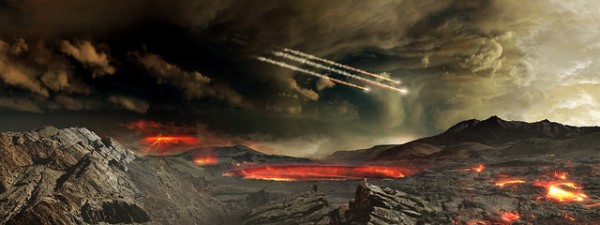By Ana Verayo, | November 18, 2016

This is an artist's concept of the young Earth being bombarded by asteroids. (NASA's Goddard Space Flight Center Conceptual Image Lab)
Based on the theory that the first human civilizations began in Mesopotamia in 3,000 B.C.E., a new study has re-examined how life began on Earth in the form of an asteroid that crashed in Mexico, forming a massive crater that wiped out all dinosaurs some 65 million years ago.
This new study details how asteroid impacts not just deforms and exposes bedrock, but can also trigger ecological responses to form new microbial life. Scientists from the Imperial College London analyzed core samples that were recovered from the peak ring inside the Chicxulub Crater.
Like Us on Facebook
This massive "crater of life" is a unique depression located in the Yucatan Peninsula. Scientists were able to study again its inner ridges.
A giant meteor crashed into Earth 65 million years ago, creating a violent and destructive explosion that caused 75 percent of all life on Earth to die, including dinosaurs. This event is also known as the Cretaceous Tertiary mass extinction event.
In this new study, the team's findings revealed that the core samples are not just evidence of how massive surface impacts can decimate life on the planet but these violent impacts can apparently induce life-friendly conditions inside Earth's bedrock.
According to the lead author of the study, Joanna Morgan of the Imperial College London, it can be hard to convince others that violent forces which wiped out dinosaurs from the face of the Earth are the same ones that triggered early life on the planet. This discovery suggests that further studies of these core samples can provide new insights about how life can thrive in subterranean environments.
More specifically, these new samples may shed light into how they transformed into less dense and more porous material as opposed to the prediction of past collision models.
This exposed bedrock inside the Chicxulub Crater revealed tiny holes that may have been the potential breeding ground for the first life forms on the planet since water and oxygen are enriched by nutrients in the ground and from the asteroid itself.
This new study was published in the journal Science.
-
Use of Coronavirus Pandemic Drones Raises Privacy Concerns: Drones Spread Fear, Local Officials Say

-
Coronavirus Hampers The Delivery Of Lockheed Martin F-35 Stealth Fighters For 2020

-
Instagram Speeds Up Plans to Add Account Memorialization Feature Due to COVID-19 Deaths

-
NASA: Perseverance Plans to Bring 'Mars Rock' to Earth in 2031

-
600 Dead And 3,000 In The Hospital as Iranians Believed Drinking High-Concentrations of Alcohol Can Cure The Coronavirus

-
600 Dead And 3,000 In The Hospital as Iranians Believed Drinking High-Concentrations of Alcohol Can Cure The Coronavirus

-
COVID-19: Doctors, Nurses Use Virtual Reality to Learn New Skills in Treating Coronavirus Patients







